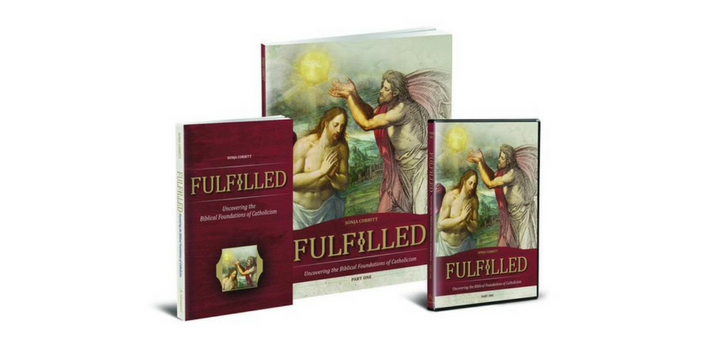
 Frequently in my travels and interactions, I hear how confused and flustered Catholics feel when confronted by sincere questions from fallen-away Catholics or non-Catholics who measure Catholicism by the Bible. Understanding one’s Catholic faith concisely, especially from the Bible, has always required cobbling apologetic material from multiple sources and authors – an arduous, confusing, and time-consuming endeavor.
Because of the inherent difficulty, Catholics have long felt unable to defend Catholic faith and practice from the Bible as deftly as their non-Catholic counterparts seem able to pick it apart using the Bible. Don’t we seem to be speaking two different languages with the same Book?
As a result, Catholics’ faith-sharing goes unheard, and under such passionate dismissal, they feel defeated and even question the veracity of their own faith. Many fall away entirely.
This reality is as intolerable to me as a fresh burn, one that I will work until my very last breath to help alleviate as a matter of sweet penance; because I was a non-Catholic who once made it her mission to “pick off” Catholics from the Church, and I was very good at it.
I used the “Roman Road” like a rapier:
Frequently in my travels and interactions, I hear how confused and flustered Catholics feel when confronted by sincere questions from fallen-away Catholics or non-Catholics who measure Catholicism by the Bible. Understanding one’s Catholic faith concisely, especially from the Bible, has always required cobbling apologetic material from multiple sources and authors – an arduous, confusing, and time-consuming endeavor.
Because of the inherent difficulty, Catholics have long felt unable to defend Catholic faith and practice from the Bible as deftly as their non-Catholic counterparts seem able to pick it apart using the Bible. Don’t we seem to be speaking two different languages with the same Book?
As a result, Catholics’ faith-sharing goes unheard, and under such passionate dismissal, they feel defeated and even question the veracity of their own faith. Many fall away entirely.
This reality is as intolerable to me as a fresh burn, one that I will work until my very last breath to help alleviate as a matter of sweet penance; because I was a non-Catholic who once made it her mission to “pick off” Catholics from the Church, and I was very good at it.
I used the “Roman Road” like a rapier:
- “There is none righteous, no, not one” (Rom 3:10).
- “All have sinned and fallen short of the glory of God” (Rom 3:23).
- “The wages of sin is death, but the gift of God is eternal life in Christ Jesus our Lord” (Rom 6:23).
- “If you confess with your mouth the Lord Jesus and believe in your heart that God has raised Him from the dead, you will be saved. For with the heart one believes unto righteousness, and with the mouth confession is made unto salvation” (Rom 10:9-10).
- Did you see anything there about sacraments? It says believe and confess, and you will be saved. Confession to a priest? No. The Bible says that nowhere, and the Bible does not lie. Church attendance? Saints? Holy days of “obligation”? No. You must be saved, and that is all. You just read it yourself. Have you been saved? Will you go to heaven when you die? “For God so loved the world He gave His only begotten Son, that whosoever believes in Him will not perish but have everlasting life” (Joh 3:16). You must be saved, or go to hell and perish. It. Is. That. Simple.
 Fulfilled, Uncovering the Biblical Foundation of Catholicism equips you to understand and share your faith concisely in this way. You will discover the Old Testament tabernacle as the perfectly packaged biblical model for conveniently understanding and explaining seemingly arbitrary Catholic beliefs and practices – practices that can baffle and frustrate both fallen-away and non-Catholics.
As you work through the Fulfilled study, you will acquire a thorough knowledge of the tabernacle’s design, facilities, and function as the blueprint for the fullness of faith; you will know clearly how they refer to Christ and the Church and come to appreciate why the Catholic Church must show you how to practice it anew as its plenitude in Christ; and you will survey the landscape with amazement that your own faith is fulfilled more completely as you begin to evangelize confidently.
Fulfilled, Uncovering the Biblical Foundation of Catholicism equips you to understand and share your faith concisely in this way. You will discover the Old Testament tabernacle as the perfectly packaged biblical model for conveniently understanding and explaining seemingly arbitrary Catholic beliefs and practices – practices that can baffle and frustrate both fallen-away and non-Catholics.
As you work through the Fulfilled study, you will acquire a thorough knowledge of the tabernacle’s design, facilities, and function as the blueprint for the fullness of faith; you will know clearly how they refer to Christ and the Church and come to appreciate why the Catholic Church must show you how to practice it anew as its plenitude in Christ; and you will survey the landscape with amazement that your own faith is fulfilled more completely as you begin to evangelize confidently.
Visit our Book Notes archive.
Copyright 2018 Sonja Corbitt
About the Author
Sonja Corbitt
Sonja Corbitt is the Bible Study Evangelista, a Catholic Scripture teacher with a story teller’s gift – a Southern Belle with a warrior’s heart and a poet’s pen. Catch her newest study series on Healing the Father Woundnow. . What's an "evangelista"? Find out at biblestudyevangelista.com . Instagram | Pinterest


.png?width=1806&height=731&name=CatholicMom_hcfm_logo1_pos_871c_2728c%20(002).png)
Comments